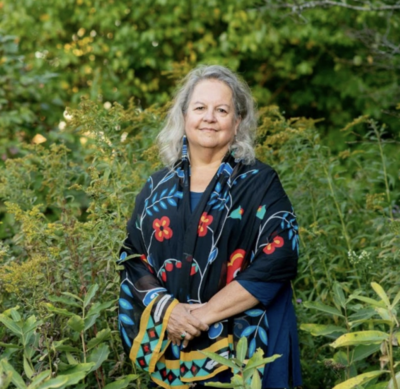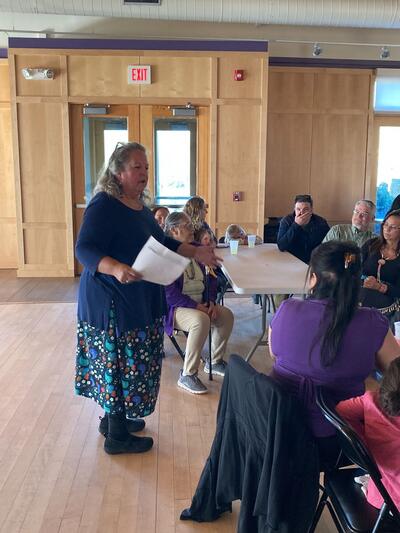Celebrating the decade-long impact of Braiding Sweetgrass
Robin Wall Kimmerer didn’t set out to change the world—or even to become particularly famous within the canon of environmental literature, which was infamously comprised of homogeneously white voices for decades. Rather, the Indigenous ecologist-turned-author seemed to be operating like a scientist from the outset: her observations led her to understand that the world needed a change, and so she proposed an effective solution. In the face of ongoing biodiversity loss and climate change, Kimmerer observed that scientists had the tools to enact necessary change, but Indigenous communities held the spirit and ancestral knowledge vital to doing so with dignity and respect for the earth.

But how to encourage a respectful collaboration between these two seemingly disparate groups, whose viewpoints have been framed in diametric opposition since time immemorial despite their common goals? After more than three decades of straddling the divide between her own scientific and Indigenous communities, Kimmerer longed to facilitate unity between the realms of empirical knowledge of the earth and Native wisdom on how to live peacefully within it. So developed her treatise: Braiding Sweetgrass: Indigenous Wisdom, Scientific Knowledge, and the Teachings of Plants, a book that, in Kimmerer’s own words, is “a powerful invitation to look at the world through multiple streams of knowledge, not just one.”
However softly Braiding Sweetgrass first landed in the marketplace in 2013, it would only become a matter of time before its transformative effect rippled outward, swaying the hearts and minds of countless booksellers, readers, scientists, policymakers, and earth-lovers alike. Within the span of a few whirlwind years, Kimmerer’s book would become so well-known that it would reach the ears of influential artists creating response art to global climate movements, as well as representatives from the United Nations (where Kimmerer herself was invited as a guest speaker) and A-list celebrity reading lists. The book has since sold over 1.6 million copies throughout the country, has been translated into 20 languages, has spent three years on the New York Times Bestseller list, and has just this year been adapted into an edition for young readers. But for Kimmerer, this is only the beginning.

When the Center for Native Peoples and the Environment (CNPE) was founded at the SUNY college of Environmental Science and Forestry in 2006, it was the manifestation of a long-held dream. Thanks in no small part to the wide-reaching success of Braiding Sweetgrass, Kimmerer was able to fund much of the Center’s continued development herself and reach like-minded visionaries who were moved to join her mission of further integrating Indigenous frameworks into the Western scientific world. Today, the Center boasts a flagship program (Native Earth) which is well into its twelfth year, dedicated to educating and empowering the next generation of Indigenous environmental scholars and their allies; and a core team of seven dedicated members who spread their expertise across three central branches: collaborative research, community-led partnerships, and environmental education. To name just one example of the success the CNPE has already achieved, their group was pivotal in securing an unprecedented return of 1,000 acres of ancestral lands to the Onondaga Nation by the New York State Department of Environmental Conservation as part of the Onondaga Lake Natural Resource Damage Assessment and Restoration Program.
In Kimmerer’s own words about the Center, she says, “We find ourselves at an extraordinary moment, when after years of attempted erasure, there is an opening of respect and recognition for Indigenous environmental knowledge. The combined crises of climate change, biodiversity loss and social justice reckoning lend urgency to the moment. At the same time as we recognize the power of the change underway and the imperative of response, we remain committed to the long, patient work of cultural shift grounded in respectful relationship with lands and people.” Like her book, Braiding Sweetgrass, the CNPE began with a single seed of hope, and an idea for how to translate it across many audiences. Also like her book, the CNPE has grown into an influential change-agent in its own right, and to this end, Kimmerer says, “the Center has grown a reputation as a voice for bringing together Indigenous knowledge and the tools of western science in service to land and community.”
For Milkweed Editions, incorporating Indigenous voices and perspectives into our list is not something done simply for the sake of diversity; especially as it intersects with our standing as a leader in the public discourse of contemporary environmental literature, we know that it is essential to look to the wisdom and lifeways of Indigenous peoples, whose passion and knowledge for reciprocal ways of living on the earth are the key to finding solutions to many of our greatest challenges today. For every person who has resonated with our mission, or who has read or recommended Robin Wall Kimmerer’s Braiding Sweetgrass, we thank you for championing our work, and for being part of the growing percentage of change-makers in the world today. Your support and enthusiasm ensures that stories like this one continue to ripple outward, creating legacies of transformation and mutual flourishing for decades to come.

